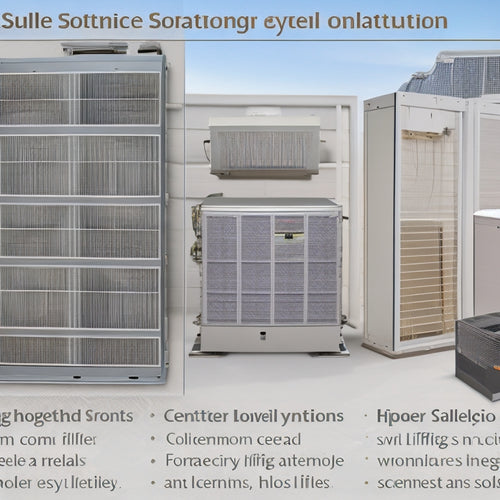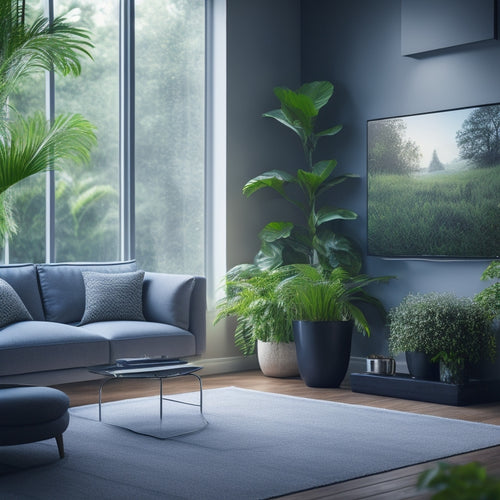
Integrate Home Devices for Maximum Energy Savings
Share
By integrating your home devices, you can access significant energy savings, with the potential to reduce your energy waste by up to 40% by eliminating standby power consumption alone. A smart home hub centralizes control, providing real-time visibility into energy consumption and enabling informed decisions. Automated scheduling optimizes consumption during peak and off-peak hours, while energy storage systems allow for excess energy storage. You can identify areas for improvement, eliminate standby power consumption, and change ordinary devices into energy-conscious allies. As you investigate integrated energy management, you'll find even more ways to maximize your energy savings and take control of your energy freedom.
Key Takeaways
- Centralize control of home devices with a smart home hub for real-time energy management and optimization.
- Integrate energy storage systems to store excess energy for peak use and reduce energy waste.
- Automate device scheduling to optimize consumption during peak and off-peak hours, reducing energy bills.
- Use smart power strips with scheduling features to eliminate standby power consumption and track energy usage.
- Implement advanced optimization capabilities to streamline device operation and reduce overall energy consumption.
Simplifying Energy Management
Your smart home hub becomes the command center for simplifying energy management, allowing you to monitor and control various devices from a single interface.
This centralization gives you real-time visibility into your energy consumption, enabling you to make informed decisions about your energy usage.
By integrating energy storage systems, you can store excess energy for peak hours or nighttime use, optimizing your energy consumption.
You can set automated scheduling to optimize energy consumption during peak and off-peak hours, reducing waste and saving you money.
By integrating your devices, you gain a deeper understanding of your energy habits and can make adjustments to achieve maximum efficiency.
With your smart home hub, you're in control, making it easy to reduce your carbon footprint and enjoy the freedom that comes with energy independence.
Smart Power Strip Benefits
Efficiency converges with innovation in the form of smart power strips, which convert ordinary devices into intelligent, energy-conscious allies. You can now control and monitor the energy usage of your devices remotely, optimizing your energy consumption and reducing energy costs. Smart strips also eliminate standby power consumption, a significant contributor to energy waste.
| Smart Strip Features | Benefits |
|---|---|
| Scheduling | Automate device turn-off during periods of inactivity |
| Energy Monitoring | Track energy usage and identify areas for improvement |
| Remote Control | Turn devices on/off and adjust settings from your smartphone |
Real-Time Energy Monitoring
With over 40% of home energy waste attributed to standby power consumption, real-time energy monitoring becomes an important feature in smart power strips.
You'll have a clear view of your energy usage and consumption patterns, enabling you to take control of your energy freedom. By adopting sustainable practices and investing in eco-friendly charging infrastructure, you can greatly reduce your carbon footprint Renewable Energy Sources.
This integration is especially vital when it comes to Electric Vehicles, as approximately 80% of EV energy is sourced from renewables like solar, wind, hydro, and geothermal.
- Instant alerts: Receive notifications when devices are consuming excessive energy, allowing you to take immediate action.
- Detailed analytics: Get a breakdown of your energy usage, helping you identify areas for improvement.
- Customizable thresholds: Set energy usage limits for specific devices, ensuring you stay within your desired energy budget.
Optimizing Device Performance
Streamline your device operation by leveraging advanced optimization capabilities. By fine-tuning your devices, you can release significant energy savings.
Start by identifying areas of inefficiency, such as devices that consume excessive power in standby mode. Then, implement energy optimization strategies, like scheduling devices to turn off or enter low-power modes when not in use.
Additionally, consider optimizing your solar panel array design, including tilt, sizing, and orientation, to maximize energy production optimal energy generation.
You can also optimize device performance by adjusting settings, like brightness and resolution, to reduce energy consumption.
By maximizing device efficiency, you'll not only reduce your energy bills but also extend the lifespan of your devices.
With optimized devices, you'll have more freedom to enjoy your home, guilt-free and worry-free.
Seamless Integration Process
Most of your home devices can be integrated into a single, cohesive system, allowing you to control and monitor their performance from a central hub. This seamless integration process guarantees device compatibility and a user-friendly interface.
Imagine having complete control over your home's energy usage at your fingertips. By leveraging government incentives, you can substantially reduce the initial costs of integrating renewable energy solutions, making it a more viable option for homeowners.
Additionally, with data visualization tools, you can illustrate the financial benefits of energy-efficient systems, enhancing communication and providing clear justification for investment.
- Unified Control: Manage all your devices from a single platform, eliminating the need for multiple apps and remotes.
- Streamlined Energy Monitoring: Track your energy consumption in real-time, identifying areas for improvement and optimizing your energy savings.
- Enhanced Automation: Create customized automation scenes that learn your habits and preferences, guaranteeing maximum energy efficiency and convenience.
Frequently Asked Questions
Can I Control Devices Remotely With My Smartphone or Tablet?
You can control devices remotely with your smartphone or tablet, enjoying remote access and smartphone compatibility, allowing you to manage your home's energy usage from anywhere, at any time, giving you ultimate freedom and convenience.
Are Integrated Home Devices Compatible With My Existing Smart Speaker?
You'll be amazed to know that 70% of smart homes have voice-controlled devices! Now, about compatibility: yes, most integrated home devices seamlessly sync with your existing smart speaker, ensuring effortless speaker integration and device compatibility for a truly liberated living experience.
Do I Need to Replace All Devices at Once for Integration to Work?
You don't need to replace all devices at once; gradual upgrades are possible, ensuring device compatibility. Start with a few key devices, then add more over time, allowing you to integrate and optimize your smart home system at your own pace.
Will Integrating Devices Affect My Internet Bandwidth and Speed?
You're right to wonder if integrating devices will slow your internet; however, most devices require minimal bandwidth, and smart allocation can prevent network congestion, ensuring you still enjoy fast speeds and freedom from digital constraints.
Are There Any Security Risks With Integrating and Controlling Devices Online?
As you open the digital doors to your smart home, beware of lurking shadows. When controlling devices online, you're exposing yourself to potential security risks, compromising data privacy and network security, and leaving device vulnerabilities unguarded; strong encryption methods are your shield against cyber threats.
Related Posts
-

Why Solar HVAC Filters Revolutionize Home Energy Efficiency
By adopting solar HVAC filters, you're shifting your home's energy reliance from fossil fuels to clean, renewable sou...
-

7 Best Home Hydrogen Fuel Cells for Clean Power
You're considering adopting hydrogen fuel cells for clean power at home, but you want to know the best options. Reput...
-

Why Biodegradable Dish Soap Matters for Earth-Conscious Homes
You likely don't realize that the dish soap you're using today will still be harming the environment long after you'v...


